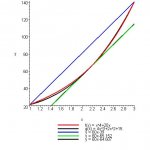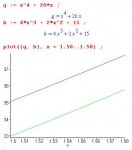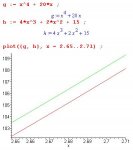Here's the problem:
Show that there is a number x in the interval (1, 3) at which the tangents to the graphs of y = x[sup:2o6qr407]4[/sup:2o6qr407] + 20x and y = 4x[sup:2o6qr407]3[/sup:2o6qr407] + 2x[sup:2o6qr407]2[/sup:2o6qr407] + 15 are parallel.
Here's what I did:
Since g'(x) and h'(x) are the slopes of the lines tangent to g and h at x, the tangents are parallel when g'(x) = h'(x) or when g'(x) – h'(x) = 0. Let f(x) = g(x) – h(x) = x[sup:2o6qr407]4[/sup:2o6qr407]4 – 4x[sup:2o6qr407]3[/sup:2o6qr407] – 2x[sup:2o6qr407]2[/sup:2o6qr407] + 20x + 15. Then f'(x) = g'(x) – h'(x) = 4x[sup:2o6qr407]3[/sup:2o6qr407] – 12x[sup:2o6qr407]2[/sup:2o6qr407] – 4x + 20 = 0. By the MVT, there is a point z between 1 and 3 for which f'(3) – f'(1) = (3 – 1)0 = 0. This is what needed to be shown.
My questions:
Is my logic correct on this? Is that all there is to solving this type of problem? Or do I need to come up with the x where the tangents are parallel? Looking at the graph of f'(x), there is a value of x where f'(x) = 0 such that 1 < x < 3, but the question wording doesn't seem to require that I solve for it.
Show that there is a number x in the interval (1, 3) at which the tangents to the graphs of y = x[sup:2o6qr407]4[/sup:2o6qr407] + 20x and y = 4x[sup:2o6qr407]3[/sup:2o6qr407] + 2x[sup:2o6qr407]2[/sup:2o6qr407] + 15 are parallel.
Here's what I did:
Since g'(x) and h'(x) are the slopes of the lines tangent to g and h at x, the tangents are parallel when g'(x) = h'(x) or when g'(x) – h'(x) = 0. Let f(x) = g(x) – h(x) = x[sup:2o6qr407]4[/sup:2o6qr407]4 – 4x[sup:2o6qr407]3[/sup:2o6qr407] – 2x[sup:2o6qr407]2[/sup:2o6qr407] + 20x + 15. Then f'(x) = g'(x) – h'(x) = 4x[sup:2o6qr407]3[/sup:2o6qr407] – 12x[sup:2o6qr407]2[/sup:2o6qr407] – 4x + 20 = 0. By the MVT, there is a point z between 1 and 3 for which f'(3) – f'(1) = (3 – 1)0 = 0. This is what needed to be shown.
My questions:
Is my logic correct on this? Is that all there is to solving this type of problem? Or do I need to come up with the x where the tangents are parallel? Looking at the graph of f'(x), there is a value of x where f'(x) = 0 such that 1 < x < 3, but the question wording doesn't seem to require that I solve for it.



